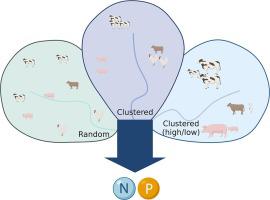Journal of Hydrology ( IF 5.9 ) Pub Date : 2022-08-11 , DOI: 10.1016/j.jhydrol.2022.128301 Lorrayne Miralha , Suraya Sidique , Rebecca Logsdon Muenich

|
Large animal operations in the United States (US) have expanded in recent decades as a solution for meeting increasing food demand. These operations can release large amounts of organic matter and nutrients into the environment, potentially impacting water quality conditions of nearby waterbodies. Often referred to as animal feeding operations (AFOs) or CAFOs (concentrated AFOs) based on nomenclature in federal regulations, these operations are usually clustered in space, which may intensify the impacts observed. However, the influence of the known spatial aggregation of CAFOs on water quality conditions has not been evaluated. This study investigates the spatial organization of CAFOs and its relationship to water quality conditions. We hypothesized that watersheds with clustered CAFOs are likely to be associated with higher concentrations of Total Phosphorus (TP) and Total Nitrogen (TN) in the US. We gathered and digitized CAFO locations in 16 US states and used TP and TN concentration data to evaluate our hypothesis. We calculated the flow-weighted mean concentration of TN and TP from 2005 to 2014 and averaged those values per season. We used the nearest neighbor index (NNI) to determine the spatial pattern (i.e., clustering or dispersed) of CAFOs per watershed and its significance level. Additionally, for states with animal number information per farm, we performed a Local Moran’s I analysis to understand if the clustering of CAFOs with a low or high number of animals relates to the TP and TN concentrations of each nearest water quality station. Overall, we found that watersheds with significant clustering patterns were associated with higher TP and TN levels. Seasonally, this finding also held principally during spring and summer seasons, when manure tends to be land applied. Our Local Moran’s I analysis also revealed that the clustering of smaller and medium-sized farms, usually less regulated, is associated with elevated TP and TN concentrations. This reveals that the small, yet potentially unregulated farms could be highly impactful to the environment, which warrants further study. Given the lack of information on the influence of CAFO clustering (and other pollutant source clustering) on water quality and that most states do not regulate emitters based on this aspect, our outcomes advance the knowledge of how these entities may be driving changes to the environment. This study also brings insights into new water quality modeling approaches and supports future policy decisions.
中文翻译:

美国 CAFO 的空间组织及其与水质的关系
近几十年来,作为满足日益增长的食品需求的解决方案,美国 (US) 的大型动物养殖场不断扩大。这些操作会向环境中释放大量有机物和营养物质,可能会影响附近水体的水质状况。根据联邦法规中的命名法,通常被称为动物饲养操作 (AFO) 或 CAFO(集中 AFO),这些操作通常在空间中聚集,这可能会加剧观察到的影响。然而,尚未评估已知的 CAFO 空间聚集对水质条件的影响。本研究调查 CAFO 的空间组织及其与水质条件的关系。我们假设具有聚集 CAFO 的流域可能与美国较高的总磷 (TP) 和总氮 (TN) 浓度有关。我们收集并数字化了美国 16 个州的 CAFO 位置,并使用 TP 和 TN 浓度数据来评估我们的假设。我们计算了 2005 年至 2014 年 TN 和 TP 的流量加权平均浓度,并对每个季节的这些值进行平均。我们使用最近邻指数 (NNI) 来确定每个流域 CAFO 的空间模式(即聚集或分散)及其显着性水平。此外,对于每个农场有动物数量信息的州,我们执行了 Local Moran's 我们计算了 2005 年至 2014 年 TN 和 TP 的流量加权平均浓度,并对每个季节的这些值进行平均。我们使用最近邻指数 (NNI) 来确定每个流域 CAFO 的空间模式(即聚集或分散)及其显着性水平。此外,对于每个农场有动物数量信息的州,我们执行了 Local Moran's 我们计算了 2005 年至 2014 年 TN 和 TP 的流量加权平均浓度,并对每个季节的这些值进行平均。我们使用最近邻指数 (NNI) 来确定每个流域 CAFO 的空间模式(即聚集或分散)及其显着性水平。此外,对于每个农场有动物数量信息的州,我们执行了 Local Moran's我分析以了解具有少量或大量动物的 CAFO 的聚类是否与每个最近的水质站的 TP 和 TN 浓度有关。总体而言,我们发现具有显着聚类模式的流域与较高的 TP 和 TN 水平相关。季节性地,这一发现也主要出现在春季和夏季,此时肥料往往会被用于土地施用。我们当地的 Moran's I分析还显示,通常监管较少的中小型农场的聚集与 TP 和 TN 浓度升高有关。这表明小型但可能不受监管的农场可能对环境产生巨大影响,这值得进一步研究。鉴于缺乏关于 CAFO 聚类(和其他污染物源聚类)对水质影响的信息,并且大多数州并未基于这方面对排放者进行监管,我们的结果提高了对这些实体如何推动环境变化的认识. 这项研究还为新的水质建模方法提供了见解,并支持未来的政策决策。











































 京公网安备 11010802027423号
京公网安备 11010802027423号